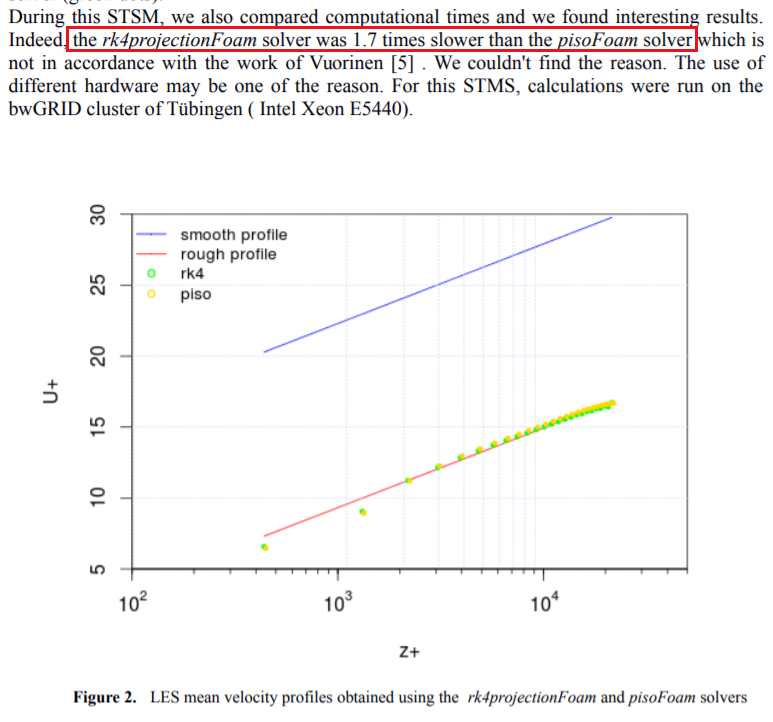projection method 真的比piso快吗?
-
这两天看了一篇文献关于使用四阶龙格库塔时间推进代替PISO算法,他的结果显示要比piso快50%,而且精度还高。因为他是有公布代码,所以修改起来很容易(我不太确定改的对不对)。这是我的修改的代码:
#include "CreatePoissonMatrix.H" Info<< "\nStarting time loop\n" << endl; while (runTime.run()) { #include "readTimeControls.H" #include "CourantNo.H" #include "setDeltaT.H" runTime++; Info<< "Time = " << runTime.timeName() << nl << endl; Uold =U; Uc=U; phi =(fvc::interpolate(U) & mesh.Sf()); dU= runTime.deltaT()*(fvc::laplacian(turbulence->nuEff(),U)-fvc::div(phi,U)); Uc =Uc +a1*dU; U=Uold+0.5*dU; #include "PressureCorrection.H" phi =(fvc::interpolate(U) & mesh.Sf()); dU= runTime.deltaT()*(fvc::laplacian(turbulence->nuEff(),U)-fvc::div(phi,U)); Uc =Uc +a2*dU; U=Uold+0.5*dU; #include "PressureCorrection.H" phi =(fvc::interpolate(U) & mesh.Sf()); dU= runTime.deltaT()*(fvc::laplacian(turbulence->nuEff(),U)-fvc::div(phi,U)); Uc =Uc +a3*dU; U=Uold+dU; #include "PressureCorrection.H" phi =(fvc::interpolate(U) & mesh.Sf()); dU= runTime.deltaT()*(fvc::laplacian(turbulence->nuEff(),U)-fvc::div(phi,U)); Uc =Uc +a4*dU; U=Uc; #include "PressureCorrection.H" phi =(fvc::interpolate(U) & mesh.Sf()); laminarTransport.correct(); turbulence->correct(); #include "continuityErrs.H" runTime.write(); Info<< "ExecutionTime = " << runTime.elapsedCpuTime() << " s" << " ClockTime = " << runTime.elapsedClockTime() << " s" << nl << endl; }其中:
PressureCorrection..H为U.correctBoundaryConditions(); solve( pEqn == fvc::div(U)/runTime.deltaT()); U = U -fvc::grad(p)*runTime.deltaT(); U.correctBoundaryConditions();CreatePoissonMatrix.H为:
fvScalarMatrix pEqn ( fvm::laplacian(p) ); pEqn.setReference(pRefCell,pRefValue);目前有两个问题,一:我算pityDaily这个算例,对比过速度确实快一些,(前提是piso也是循环四次,但是piso一般两次就够了),但是这里有个很大的问题,p残差很高,精度不高,所以不知道是我改的求解器有问题还是这个算法本身不是很好?
二:我本来想算cavity这个算例,结果一算就崩了,所以不是很确定我改的对不对。在此问下大神们有什么意见或者见解。:big_mouth:
-
@李东岳 ,log文件太大了,我直接贴出最后运行的部分,这个是piso的:
Courant Number mean: 0.0727094 max: 0.318223 smoothSolver: Solving for Ux, Initial residual = 0.00233765, Final residual = 9.36774e-07, No Iterations 2 smoothSolver: Solving for Uy, Initial residual = 0.00221123, Final residual = 1.10021e-06, No Iterations 2 GAMG: Solving for p, Initial residual = 0.02495, Final residual = 0.00191592, No Iterations 16 time step continuity errors : sum local = 1.98408e-07, global = -2.5675e-08, cumulative = -5.27605e-07 GAMG: Solving for p, Initial residual = 0.0114244, Final residual = 0.000956831, No Iterations 6 time step continuity errors : sum local = 8.06665e-08, global = -1.4887e-08, cumulative = -5.42492e-07 GAMG: Solving for p, Initial residual = 0.000984314, Final residual = 9.17457e-05, No Iterations 12 time step continuity errors : sum local = 7.76255e-09, global = -1.02027e-09, cumulative = -5.43512e-07 GAMG: Solving for p, Initial residual = 0.000126896, Final residual = 8.14763e-07, No Iterations 9 time step continuity errors : sum local = 6.93864e-11, global = 1.58971e-11, cumulative = -5.43496e-07 smoothSolver: Solving for k, Initial residual = 0.00183417, Final residual = 6.75215e-07, No Iterations 2 bounding k, min: 0 max: 0.61915 average: 0.0500166 ExecutionTime = 880.24 s ClockTime = 907 s这个是rk4projectionfoam:
Courant Number mean: 0.0691815 max: 0.254882 Time = 0.1 GAMG: Solving for p, Initial residual = 0.197725, Final residual = 0.014632, No Iterations 4 GAMG: Solving for p, Initial residual = 0.0293635, Final residual = 0.00242183, No Iterations 8 GAMG: Solving for p, Initial residual = 0.215681, Final residual = 0.0184253, No Iterations 3 GAMG: Solving for p, Initial residual = 0.0182562, Final residual = 0.00127419, No Iterations 8 smoothSolver: Solving for k, Initial residual = 0.00192867, Final residual = 7.26218e-07, No Iterations 2 bounding k, min: 0 max: 1.08318 average: 0.0514211 time step continuity errors : sum local = 1.74224e-05, global = -1.07657e-07, cumulative = -0.0014665 ExecutionTime = 621.75 s ClockTime = 640 s[0_1506409559511_rk4projectionfoam.rar](正在上传 100%)



